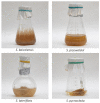Hairy Roots of Scutellaria spp. (Lamiaceae) as Promising Producers of Antiviral Flavones
- PMID: 34199058
- PMCID: PMC8271535
- DOI: 10.3390/molecules26133927
Hairy Roots of Scutellaria spp. (Lamiaceae) as Promising Producers of Antiviral Flavones
Abstract
We measured and studied the growth parameters and the qualitative and quantitative composition of the flavones of hairy roots of the Scutellaria genus: S. lateriflora, S. przewalskii and S. pycnoclada. Hairy roots were obtained using wild-type Agrobacterium rhizogenes A4 by co-cultivation of explants (cotyledons) in a suspension of Agrobacterium. The presence of the rol-genes was confirmed by PCR analysis. The hairy roots of the most studied plant from the Scutellaria genus, S. baicalensis, were obtained earlier and used as a reference sample. HPLC-MS showed the predominance of four main flavones (baicalin, baicalein, wogonin and wogonoside) in the methanol extracts of the studied hairy roots. In addition to the four main flavones, the other substances which are typical to the aerial part of plants were found in all the extracts: apigenin, apigetrin, scutellarin and chrysin-7-O-β-d-glucuronide. According to the total content of flavones, the hairy roots of the studied skullcaps form the following series: S. przewalskii (33 mg/g dry weight) > S. baicalensis (17.04 mg/g dry weight) > S. pycnoclada (12.9 mg/g dry weight) > S. lateriflora (4.57 mg/g dry weight). Therefore, the most promising producer of anti-coronavirus flavones is S. przewalskii.
Keywords: HPLC-MS/MS; S. baicalensis; S. lateriflora; S. przewalskii; S. pycnoclada; baicalein; baicalin; hairy roots; wogonin; wogonoside.
Conflict of interest statement
The authors declare no conflict of interest.
Figures





References
-
- Iauk L., Acquaviva R., Mastrojeni S., Amodeo A., Pugliese M., Ragusa M., Loizzo M.R., Menichini F., Tundis R. Antibacterial, antioxidant and hypoglycaemic effects of Thymus capitatus (L.) Hoffmanns. et Link leaves’ fractions. J. Enzyme Inhib. Med. Chem. 2015;30:360–365. doi: 10.3109/14756366.2014.930453. - DOI - PubMed
MeSH terms
Substances
Supplementary concepts
LinkOut - more resources
Full Text Sources
Miscellaneous

